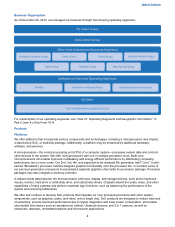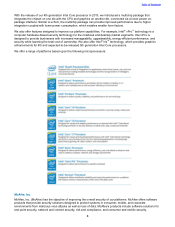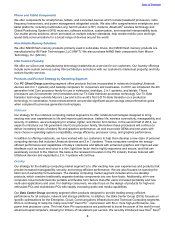Intel 2013 Annual Report Download - page 18
Download and view the complete annual report
Please find page 18 of the 2013 Intel annual report below. You can navigate through the pages in the report by either clicking on the pages listed below, or by using the keyword search tool below to find specific information within the annual report.
13
Most of our sales to distributors are made under agreements allowing for price protection on unsold merchandise
and a right of return on stipulated quantities of unsold merchandise. Under the price protection program, we give
distributors credits for the difference between the original price paid and the current price that we offer. On most
products, there is no contractual limit on the amount of price protection, nor is there a limit on the time horizon under
which price protection is granted. The right of return granted generally consists of a stock rotation program in which
distributors are able to exchange certain products based on the number of qualified purchases made by the
distributor. We have the option to grant credit for, repair, or replace defective products, and there is no contractual
limit on the amount of credit that may be granted to a distributor for defective products.
Distribution
Distributors typically handle a wide variety of products, including those that compete with our products, and fill
orders for many customers. We also utilize third-party sales representatives who generally do not offer directly
competitive products but may carry complementary items manufactured by others. Sales representatives do not
maintain a product inventory; instead, their customers place orders directly with us or through distributors. We have
several distribution warehouses that are located in proximity to key customers.
Backlog
Over time, our larger customers have generally moved to lean-inventory or just-in-time operations rather than
maintaining larger inventories of our products. As our customers continue to lower their inventories, our processes
to fulfill their orders have evolved to meet their needs. As a result, our manufacturing production is based on
estimates and advance non-binding commitments from customers as to future purchases. Our order backlog as of
any particular date is a mix of these commitments and specific firm orders that are primarily made pursuant to
standard purchase orders for delivery of products. Only a small portion of our orders is non-cancelable, and the
dollar amount associated with the non-cancelable portion is not significant.
Seasonal Trends
Historically, our platform sales have generally been higher in the second half of the year than in the first half of the
year, accelerating in the third quarter and peaking in the fourth quarter.
Marketing
Our corporate marketing objectives are to build a strong, well-known Intel corporate brand that connects with
businesses and consumers, and to offer a limited number of meaningful and valuable brands in our portfolio to aid
businesses and consumers in making informed choices about technology purchases. The Intel Core processor
family and the Intel Atom, Intel® Pentium®, Intel Xeon, Intel Xeon Phi and Intel® Itanium® trademarks make up our
processor brands.
We promote brand awareness and generate demand through our own direct marketing as well as through co-
marketing programs. Our direct marketing activities include television, print, and Internet advertising, as well as
press relations and social media, consumer and trade events, and industry and consumer communications. We
market to consumer and business audiences, and focus on building awareness and generating demand for new
form factors such as Ultrabook and 2 in 1 systems, and for increased performance, improved energy efficiency, and
other capabilities such as Internet connectivity and security.
Purchases by customers often allow them to participate in cooperative advertising and marketing programs such as
the Intel Inside® Program. This program broadens the reach of our brands beyond the scope of our own direct
marketing. Through the Intel Inside Program, certain customers are licensed to place Intel logos on computing
devices containing our microprocessors and processor technologies, and to use our brands in their marketing
activities. The program includes a market development component that accrues funds based on purchases and
partially reimburses the OEMs for marketing activities for products featuring Intel brands, subject to the OEMs
meeting defined criteria. These marketing activities primarily include television, print, and Internet marketing. We
have also entered into joint marketing arrangements with certain customers.
Table of Contents
























